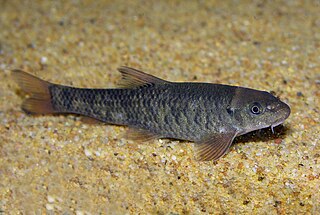
The Cyprinidae are the family of freshwater fish, collectively called cyprinids, that includes the carps, the true minnows, and their relatives. Also commonly called the "carp family", or "minnow family", Cyprinidae is the largest and most diverse fish family and the largest vertebrate animal family in general, with about 3,000 species of which only 1,270 remain extant, divided into about 370 genera. They range from about 12 mm to the 3-m Catlocarpio siamensis. The family belongs to the ostariophysian order Cypriniformes, of whose genera and species the cyprinids make up more than two-thirds. The family name is derived from the Ancient Greek kyprînos.

Cyprinus is the genus of typical carps in family Cyprinidae. Most species in the genus are of East Asia origin with only the common carp in Western Asia and Europe; this invasive species has also been introduced to many other regions around the world. Cyprinus are closely related to some more barb-like genera, such as Cyclocheilichthys and Barbonymus (tinfoils). The crucian carps (Carassius) of western Eurasia, which include the goldfish, are apparently not as closely related.

Phoxinus is a genus of freshwater fish in the family Leuciscidae of order Cypriniformes, and the only members of the subfamily Phoxininae, or Eurasian minnows. The type species is Phoxinus phoxinus. The other species in this genus are also commonly known as minnows. The name "minnow" was what early English fisherman used to describe "small and insignificant". The genus Phoxinus is found throughout Eurasia, and includes 21 known species. Previously, members of the North American genus Chrosomus were also believed to form part of this genus.
Sinocyclocheilus is a genus of freshwater fish in the family Cyprinidae endemic to China, where only found in Guangxi, Guizhou and Yunnan. Almost all of its species live in or around caves and most of these have adaptions typical of cavefish such as a lack of scales, lack of pigmentation and reduced eyes. Several species have an unusual hunchbacked appearance and some of the cave-dwellers have a "horn" on the back, the function of which is unclear. In contrast, the Sinocyclocheilus species that live aboveground, as well as a few found underground, show no clear cavefish adaptions. They are relatively small fish reaching up to 23 cm (9.1 in) in length. The individual species have small ranges and populations, leading to the status of most of the evaluated species as threatened. Many species populations in the genus have yet to be evaluated by the IUCN.

Acheilognathus is a genus of cyprinid fish native to Asia. The name is derived from the Greek a, meaning "without", the Greek cheilos, meaning "lip", and the Greek gnathos, meaning "jaw".

Garra is a genus of fish in the family Cyprinidae. These fish are one example of the "log suckers", sucker-mouthed barbs and other cyprinids commonly kept in aquaria to keep down algae. The doctor fish of Anatolia and the Middle East belongs in this genus. The majority of the more than 140 species of garras are native to Asia, but about one-fifth of the species are from Africa.

Neolissochilus is a genus of fish in the family Cyprinidae native to freshwater habitats in Asia that are often grouped with the mahseers. The largest reach up to 1.2 m (3.9 ft) in length, but most species are much smaller.

Oreonectes is a genus of fish in the family Nemacheilidae found in the rivers and cave of Asia. Many of these species are troglobitic.
Protocobitis is a genus of loaches endemic to Guangxi in China and living in caves.
Sinogastromyzon is a genus of hillstream loaches native to eastern Asia.

Triplophysa is a genus of fish in the family Nemacheilidae found mainly in and around the Qinghai-Tibet Plateau in China. Currently, the genus is a mixed assemblage of species. Some lineages have been identified and treated as subgenera, but as Wikipedia follows Fishbase for fish species these have been treated as subgenera in Wikipedia, although Kottelat and the Catalog of Fishes treat them as genera. FishBase, however, includes these in Triplophysa without specifying subgenera and treats the names given by Kottelat as synonyms.

Yunnanilus is a genus of small stone loaches that are endemic to southeastern China, especially Guangxi and Yunnan. They are found in rivers, streams and lakes; some species are restricted to caves.
The Kumaon snowtrout is a species of ray-finned fish in the genus Schizothorax.

The common snowtrout or snowtrout is a species of ray-finned fish in the genus Schizothorax. It is found in the Himalayan region of India, Bhutan, Nepal, Pakistan, and Afghanistan. It lives in mountain rivers among rocks, feeding on algae, aquatic plants and detritus, they breed in April and May. They are much sought after as a food fish. It is threatened by a number of factors including overfishing, pollution, the damming of rivers and the introduction of exotic fish, particularly salmonids and the population is declining.
Yunnanilus longibarbatus is a species of stone loach. It is endemic to the Hongshui River basin in Guangxi, southern China. It grows to 5.8 cm (2.3 in) SL.
Paranemachilus is a genus of stone loaches endemic to China.
Parasinilabeo is a genus of cyprinid fish endemic to China. There are currently six described species in this genus
Pseudocrossocheilus is a genus of cyprinid fish endemic to China. There are currently six recognized species in this genus.
Sikukia is a genus of cyprinid fish found in eastern Asia. There are currently four recognized species in this genus.
Mekongina erythrospila is a cyprinid fish endemic to the Mekong river basin. It grows to 45 cm (18 in) SL.









